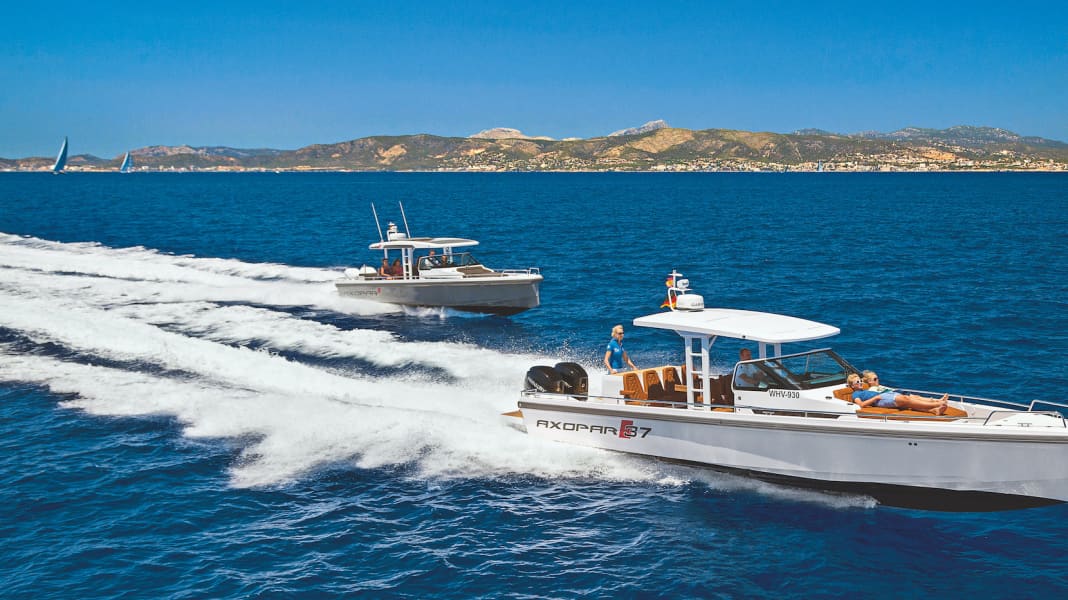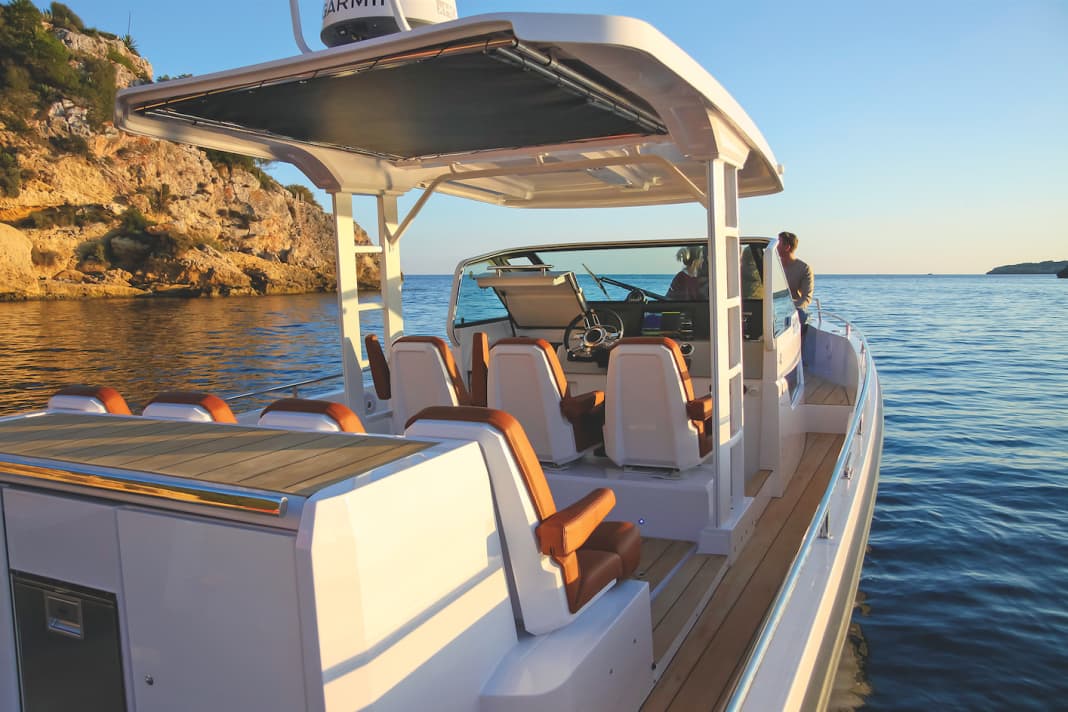






We are used to boats with that certain something from the Scandinavians and especially from the Finns. So also from Axopar. The manufacturer currently offers three models - 24, 28 and 37 (feet) - each of which is only available forOutboard motors are planned.
It's not every day that a newcomer is so successful and wins the all-important European Powerboat of the Year 2016 award on its very first appearance - with the Axopar 28.
This obviously spurred them on. The preliminary result is the37-foot serieswhich is available in various versions: open, with a hardtop and cabins at the front or with a fully enclosed superstructure. Depending on the model, this can be supplemented with a cockpit galley or aft cabin.As a drive the shipyard recommends either one or two Mercury engines from 350 hp to a maximum of 700 hp.
We sail the Axopar 37 T-Top with a fixed T-shaped bimini. At the sterntwo Mercury Verado 350 hp each on the left- and right-turning stainless steel propellers. Our sailing area is the southern coast of Mallorca, the starting point of theCalanova harbour. The test boat has a cabin with two berths, toilet and galley under the sunbed at the front.
The driver sits in front of the driver's cab in the centre between the passengers; from there he has everything in view or under control.
The three seats can be rotated through 180° so that you can dine at the table with the people sitting opposite (maximum of four).A preliminary test conclusion: According to the shipyard, the driver's seat will only be adjustable in the longitudinal direction in future, as the entire mechanism for turning and sliding gave way somewhat in the structure during extreme manoeuvres (180° turns, hooking).
The hull of the Axopar 37 is divided into three segments, which are separated by two transverse steps. The vertical, knife-shaped bow merges into a sharply cut V-shaped hull, which gradually flattens out towards the aft and is fitted with longitudinal sliding steps.
In very tight and high-speed turns, such as 180° turns, they tend to hold the hull and ultimately cause it to hook. You should therefore avoid hooking and steer the boat with sensitive fingers and full concentration.
Basically, the Axopar 37 is a fun boat with the performance data of a cruising machine - just under 6 kg net boat weight per hp are values that you encounter in the racing boat sector. However, if you refrain from hook manoeuvres and turn in a normal radius, you can sail safely at any speed.
Due to the pronounced, deep V-hull, you have to get used to the fact that the 37 tilts significantly, but ultimately safely, over its longitudinal axis when cornering at lower speeds with a large steering angle or on an imaginary slalom course.
When the rudder is jerked, i.e. in situations where you suddenly have to take evasive action, it follows the course you have set without complaint, no matter how fast you are travelling.
However, the biggest advantage of the steps is that they allow the boat to rise out of the water with increasing speed, forgetting about waves and rough water. In other words:
The Mediterranean Sea shrinks when you are travelling with an Axopar 37.
The speed at which you have to pull back the throttle on other boats because the waves affect the ride comfort is almost non-existent on our test boat. You can even put a good pound on it, pick up the pace and really increase the average speed.
In short: rough water behaviour that brings a never-ending smile to your face.
Two engines with counter-rotating propellers plus a bow thruster allow the test boat to go where it needs to go in the harbour. Mooring and unmooring are easy. We sail the slow passages at a maximum of 1500 rpm so that the waves generated by the hull do not interfere.
Thanks to the special stepped hull design, the 37 TTop transitions quickly from displacement to planing speed without any major trimming and accelerates effortlessly up to its maximum speed (48 knots). After analysing our measurement data, we calculate a speed of 25 knots as an economical planing speed.
This means that one tank of fuel is enough for a theoretical maximum range of 222 nm plus 15% reserve - which is enough for us. Respectable:
If one engine should fail, the test boat can be brought into planing speed with just the second engine and can rush towards its destination at a speed of 18 knots.
The workmanship of the test boat gives no cause for criticism, either on or below deck. And the fact that no bow roller was fitted at the front is due to a peculiarity of the Scandinavians, where boats are usually fitted with stern anchors. But the accessories list even solves this problem.

